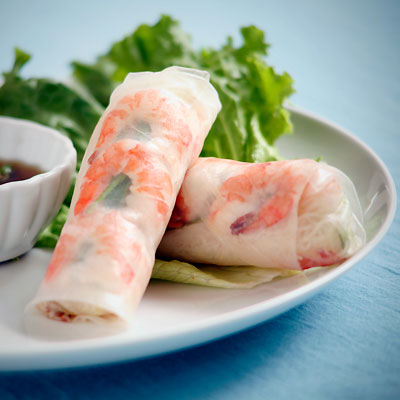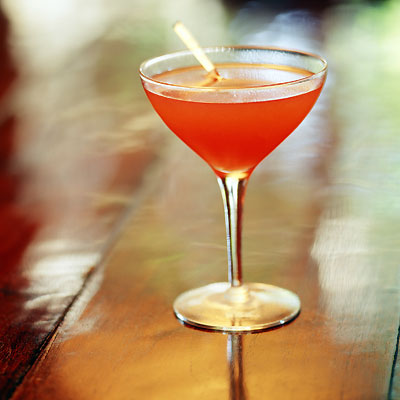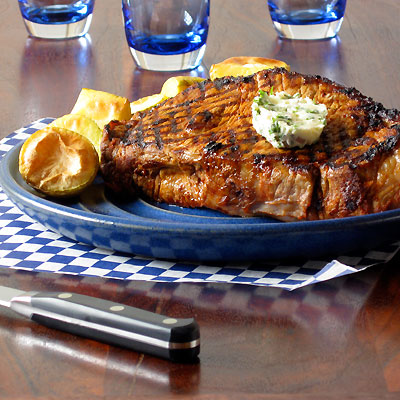
Simple and fresh, these spring rolls are easy to make and healthy too.
makes 12

Ingredients
- 2 pound small shrimp, peeled and deveined
- 3 ounce rice vermicelli
- .75 cup fresh lime juice
- 2 tablespoon sesame oil
- ¼ teaspoon kosher salt
- 12 (8 ½‑inch) rice-paper wrappers
- ½ seedless cucumber, julienned
- 1 bunch fresh chives, trimmed and cut to size
- ¼ cup asian fish sauce
- ¼ cup rice vinegar
- 2 teaspoon sugar
- 1 hot chili pepper, thinly sliced
- 1 head lettuce
- 1 bunch fresh mint
- 1 bunch fresh cilantro
Directions
Bring a large pot of water to a boil. Reduce to simmer. Add the cleaned shrimp; poach until pink, about 2 minutes, depending on size. Using a slotted spoon remove the shrimp to a bowl and cover with under cool water to stop the cooking. Drain. Slice 18 shrimp in halve length wise. Set aside.
Return the water to a boil. Add vermicelli and cook, stirring often until softened, about 2 minutes. Remove from heat and drain the noodles. Transfer them to a large bowl and toss with ¼ cup lime juice, sesame oil, and salt. Set aside.
Using a shallow bowl or pie plate filled with warm water dip a rice-paper wrapper in the water for about 5 seconds. The wrapper become slightly pliable, but remain mostly hard. It will soften further outside of the water. Let the excess water drip off and slay the wrapper onto a work surface. Lay about ¼ cup of vermicelli centered onto the bottom third of the wrapper forming it into a log shape about 3‑inches long. Top with 3 of the uncut shrimp and a small amount of cucumber. Fold both sides over the pile meeting the ends in the center. Fold the bottom flap over the pile.
Working from the bottom, carefully and as tightly as possible, but maintaining a neat uniform shape roll the wrapper ½ turn so that the vermicelli is facing up. Place 3 shrimp halves, cut side up, in a neat line just above the the pile of rolled ingredients top with 3 or 4 pieces of chive. Continue to roll so that the shrimp and chives are enclosed but visible through the rice-paper wrapper. You may let some of the chives hang over on edge if you like or neatly trim them. Place the finished roll on a plate and cover with a damp paper towel. Repeat the process 11 more times.
Serve them with lettuce leaves as a wrapper with a few mint and cilantro leaves tossed on top.


Since I don’t know where to get it, guess I won’t be eating this any time soon. It looks and sounds fascinating, but I have no clue what that tastes like!
They taste like a nutty potato. You can get them at most Latin or Asian markets. Now the coconut syrup I’ll have to look around for. GREG
Taro sounds delicious with coconut and macadamia nuts! Great to learn more about it!
I’ve boiled this and yucca before into a sticky mess. Insanely hard to clean. I am willing to try baking over a lined pan though!
Not only did I learn a lot about Taro (something I’ve never even heard of) but I now have a wonderful recipe to try. Thanks for this exotic and delicious recipe.
Wow, I have never had taro before. I saw Mike Rowe on Dirty Jobs farm it and he had to do exactly what you described — keep the top part to replant for future crops.
Thanks for stopping by my blog and the encouragement on my post! 🙂
Hey Greg, this article was so well written and interesting. I had no idea how significant a crop taro is to so many people. Plus, with delicious looking preparations like the one above, I can see where people would love it even if it wasn’t needed!
I have never cooked with raw coconut before, but this looks so interesting! You are a busy man with all of your travels!
This looks very delicious…the crunch and flavour. I love all the ingredients there. Would love to try. Thanks very much fro sharing.
I am so thrilled that many food items that are so common in India and lot of Asia is slowly being recognized in the US nowadays!! Taro is such a versatile plant. We make stir fry, curries with tuber and the leaves are stuffed and pan fried to make simply the best snack ever!!! :)) Of course the leaves are more tricky to cook than the tuber…